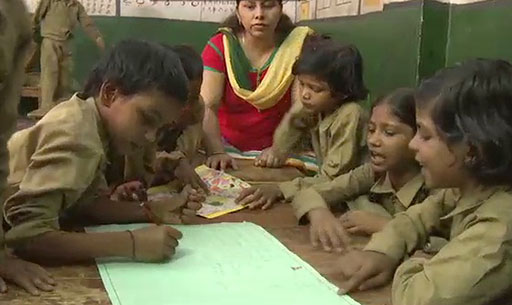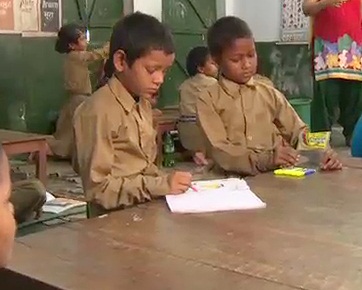2 Shared writing
At times it can be difficult for students to know how to start and what to include in a writing task. By drawing together the ideas of a number of contributors, shared writing is a collaborative way of overcoming this difficulty in the classroom.
Shared writing is particularly effective with young students who are learning to read, as it helps them to understand how thoughts can translate into speech and how spoken language can in turn be captured in writing. However, it is valuable with all levels of students.
Now read the two examples in Case Study 2.
Case Study 2: Turning students’ words into writing
Ms Usha is a Class II teacher in a rural school near Varanasi.
I regularly cut out pictures from magazines and promotional material. They include images of places, people and animals. I try to find colourful, funny and unusual pictures wherever possible. I have quite a collection now.
I do this writing activity with a small group of students in turn, giving the rest of the class another task to do at the same time. I begin by distributing a picture to the group of students and give them a short while to discuss it together. I then invite different students to say something about the picture. I write what they say on the blackboard.
When everyone has contributed, I read out what they have said, pointing to the words as I do so. We then look at the sentences and re-arrange them to make a coherent story. We read the story aloud together, inserting further words and phrases to make it flow and to add to its interest. When everyone is happy with the story, we agree a suitable title.

I then write out the story on chart paper and hang it on the classroom wall, followed by the names of the students who contributed.
I ask my students to copy out the story neatly in their exercise books, and illustrate it with suitable pictures.
Mr Gulab is a Class VIII teacher in a large school in Bhagalpur.
My students were very upset about a government plan to move the local market to a more distant location. This would inconvenience many families in the community who bought and sold goods there.
My students wanted to write a protest letter to the local governor. I agreed to help them to do this. I gave each group of six a piece of paper and told them to write down the main points they wanted to make about the plan to move the market.

When they had finished, I asked each group report back to the whole class. As they did so, I wrote their ideas on the blackboard. Sometimes their language was very angry, so I explained the importance of making their points respectfully, and the need to support these points with good reasons, if they wished to persuade the governor to pay attention. Together, we made several drafts of the letter on the blackboard, re writing the points and making the language more formal.
I then asked my students to write out the final version of the letter so that they had their own copy. They then selected one of these, added their signatures and posted it to the governor.
My students also had the idea of starting a petition to show the governor the weight of local feeling against moving the market. We therefore used the same shared writing process to write a short text protesting against the move, as an introduction to the petition. My students then arranged a rota to take the petition into the community over several days to ask people to sign it.
Pause for thought Consider the following questions for each of the above case studies:
|
The key resource ‘Using groupwork’ may be helpful at this stage.
Activity 2: Planning a writing-focused lesson
Choose either of the accounts of classroom practice in Case Study 2 and write out a lesson plan for the shared writing activity that they describe.
Try to include as much detail as you can. Start by identifying the resources you will require and be sure to estimate the time needed for each stage of the activity. You can spread the stages over several lessons if you prefer.
Refer to Resource 1 for further guidance on planning lessons.
Here is the start of an example plan based on Ms Usha’s account. You may wish to use a table format, however.
Lesson plan: Ms Usha’s shared writing activity.
Objectives:
- To encourage students to make the connection between thoughts, speech and writing.
- To encourage pair discussions using pictures as prompts.
- To encourage students to contribute to whole class story creation .
Resources:
- Magazine photos or pictures cut out or photocopied, large enough for students to see clearly.
Timing:
- Ten minutes to introduce the pictures.
- Five minutes for students to talk in pairs about the pictures.
- Twenty minutes for a whole-class talk about what the pictures show.
Keep your completed plan, as it will provide you with a model to use in Activities 3 and 4 that follow.
Video: Planning lessons |
Activity 3: Writing for real audiences and purposes
With your colleagues, think of as many opportunities as you can for your students to write for real audiences and purposes.
Here are some possibilities. You will be able to add others that are suited to your particular context, as well as your students’ age and experience.
Your students could:
- write and illustrate birthday or festival cards for their families
- make simple books for babies in the village
- write stories or poems for younger children in the school
- become ‘pen pals’ with a class in another district or city, using connections from the DIET
- write a letter to an author, performer or politician, asking questions about their work
- make posters about a health-related issue, such as the importance of hand-washing, to place around and outside the school
- write out recipes used at home and compile a class cookbook to photocopy and distribute
- write to the local paper, giving their views about a topical local concern
- create a ‘Welcome Guide’ to the school, containing advice for new students
- produce a guide to their village or district.
For all the suggestions you list, makes notes on:
- who the intended audience of the writing is (parents, other students, local people, visitors, etc.)
- what the purpose of the writing is (to inform, entertain, persuade, teach, etc.)
- how you might model the type of writing to be done (you may show your students a real example, provide them with a general outline, list the key words and phrases to include, etc.)
- how you would balance composition and transcription-related tasks within the writing activity.
Activity 4: Implementing a shared writing lesson with your students
Select one of the ideas in your list and prepare to try it out with your class. Using the lesson plan that you devised earlier as a guide, write a new plan for this lesson, ensuring that you take account of:
- the audience and purpose of the task
- the nature of the shared writing element
- the balance of time to be spent on composition and transcription.
You might find it helpful to try out the activity with your colleagues first. Invite their feedback and adapt your lesson plan accordingly. When you are ready, implement the lesson in your class.
In order to draw your students’ attention to the different aspects of the writing process, provide them with a running commentary of the changes you are making to the shared text, in response to their suggested improvements. These might relate to aspects of its style – for example, whether it is formal or informal, its vocabulary, or its sequencing and flow. Read out what you have written as you go along to check how it sounds as it is progressively modified. In so doing, you are showing your class that good composition needs thought and attention.
At the same time you should demonstrate transcriptional skills by using neat writing and even spacing, and by pointing out appropriate punctuation, spelling and grammar. Explain how such details can contribute to the overall effect of the text on the intended audience.
Pause for thought
|
Shared writing is sociable and collaborative. It is supportive of students who are unsure of what to write and who are nervous of making transcriptional errors when they do so. It demonstrates the processes of drafting and rewriting to students.
1 Writing in the real world
